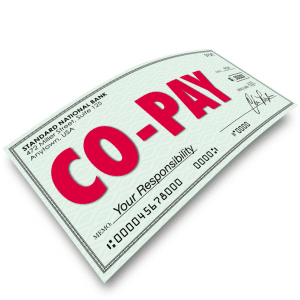
To “Copay” or not to “Copay” THAT is the question!
A “Copay” is a fixed dollar amount the plan member pays for a health care service at the time of service. The copay bypasses the deductible, but is credited towards the out-of-pocket maximum.
In traditional health plans, there are often copays for physician office visits as well as prescription drugs. For example, the member may pay a $50 copay for a primary care physician office visit and a separate copay for any prescribed medications.
It is important to note that the $50 copay does not completely pay the doctor’s $80 negotiated fee. The insurance company uses premium dollars to pay the remainder of the doctor’s fee ($30). That is why plans with copays are more expensive than plans without copays. Health plans with very low copays are substantially more expensive.
With an HSA-qualified health plan, Federal regulations require that the health plan not have copays for office visits and prescription drugs until the plan deductible has been met. Because there are no copays, the plan member can instead open a tax-free health savings account or HSA to pay for healthcare services with tax-free dollars.
Important Note: Surprisingly, when you compute how much you need to “earn” in order to pay a copay, you discover the amount is fairly close to the negotiated fee. Read on . . .
- In order to pay a $50 copay for an office visit, the employee really needs to earn $75, which includes $25 being withheld by the employer for taxes, in order to have the after-tax amount of $50 to pay the copay. Hence the “real” cost of $75 is what the employee needs to earn.
Here’s a different way: A plan member has a health savings account, and needs to pay the $80 negotiated fee. So, employee payroll deducts $80 tax-free which goes into the HSA, and then the employee pays the $80 negotiated fee from their HSA account. Paying the negotiated fee of $80 with tax-free dollars is fairly close to the $75 a member needs to earn in order to pay an after-tax copay of $50.
